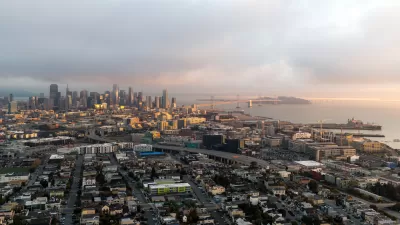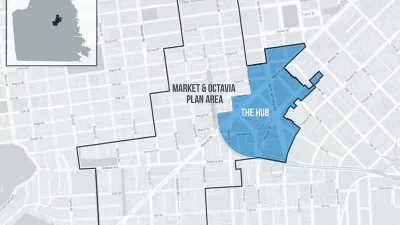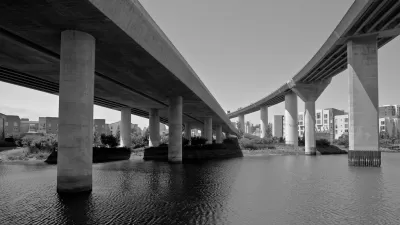An incredibly complex development proposal for 20 acres of Caltrain railyard is back on the table, nearly a decade since it first made news in San Francisco.

A proposal that would redevelop the Caltrain yard in San Francisco into a massive redevelopment project—which has been making the Planetizen newswire since 2013—has new life.
According to a paywalled article by J.K. Dineen for the San Francisco Chronicle, the Caltrain yard is one of the Bay Area's most complicated sites—20 acres of railyard straddling the space between the neighborhoods of South of Market (SoMa) and Mission Bay. One of the key challenges to the project would be moving the railyards underground.
So after four years of quiet, what does the new interest in the project look like? Dineen reports:
This week Caltrain and developer Prologis, which owns the 20-acre site, are working jointly with architects and engineers and other public agencies to complete a “business case study” that will lay out solutions for both the future of rail in San Francisco and potential development — likely a lot of housing — on whatever land is freed up by the reconfiguration of the station at Fourth and King streets and the rail yards that stretch four blocks.
A virtual public meeting was held earlier this month, and already the conversation around the project is taking a different tone in a city famous for development controversy:
The potential redevelopment of the rail yards is different from other big public-private megaprojects because the conversation will not be driven by the normal San Francisco fights around affordable housing or building heights or open space. It will be shaped by the question of what best serves the future of Caltrain and high-speed rail.
San Francisco is one of the cities in California facing the prospect of losing local control of zoning regulation after running afoul of state law and not planning adequately for new housing—a group that includes Redondo Beach in Southern California and Palo Alto and Cupertino in the Bay Area.
While the 20-acre site is capable of providing thousands of housing unit, according to Leigh Lutenski, a deputy director at the San Francisco Office of Economic and Workforce Development, the project's backers are "thinking in broad strokes about land uses and densities" at this point in the process.
FULL STORY: A big S.F. rail yard project has goals of transforming transit. Could it also bring more housing? [paywall]

Trump Administration Could Effectively End Housing Voucher Program
Federal officials are eyeing major cuts to the Section 8 program that helps millions of low-income households pay rent.

Planetizen Federal Action Tracker
A weekly monitor of how Trump’s orders and actions are impacting planners and planning in America.

Ken Jennings Launches Transit Web Series
The Jeopardy champ wants you to ride public transit.

Philadelphia Is Expanding its Network of Roundabouts
Roundabouts are widely shown to decrease traffic speed, reduce congestion, and improve efficiency.

Why Bike Lanes Are Good: An Explainer for the US Transportation Secretary
Sean Duffy says there’s no evidence that bike lanes have benefits. Streetsblog — and federal agencies’ own data — beg to differ.

California Invests Additional $5M in Electric School Buses
The state wants to electrify all of its school bus fleets by 2035.
Urban Design for Planners 1: Software Tools
This six-course series explores essential urban design concepts using open source software and equips planners with the tools they need to participate fully in the urban design process.
Planning for Universal Design
Learn the tools for implementing Universal Design in planning regulations.
Ada County Highway District
Clanton & Associates, Inc.
Jessamine County Fiscal Court
Institute for Housing and Urban Development Studies (IHS)
City of Grandview
Harvard GSD Executive Education
Toledo-Lucas County Plan Commissions
Salt Lake City
NYU Wagner Graduate School of Public Service





























